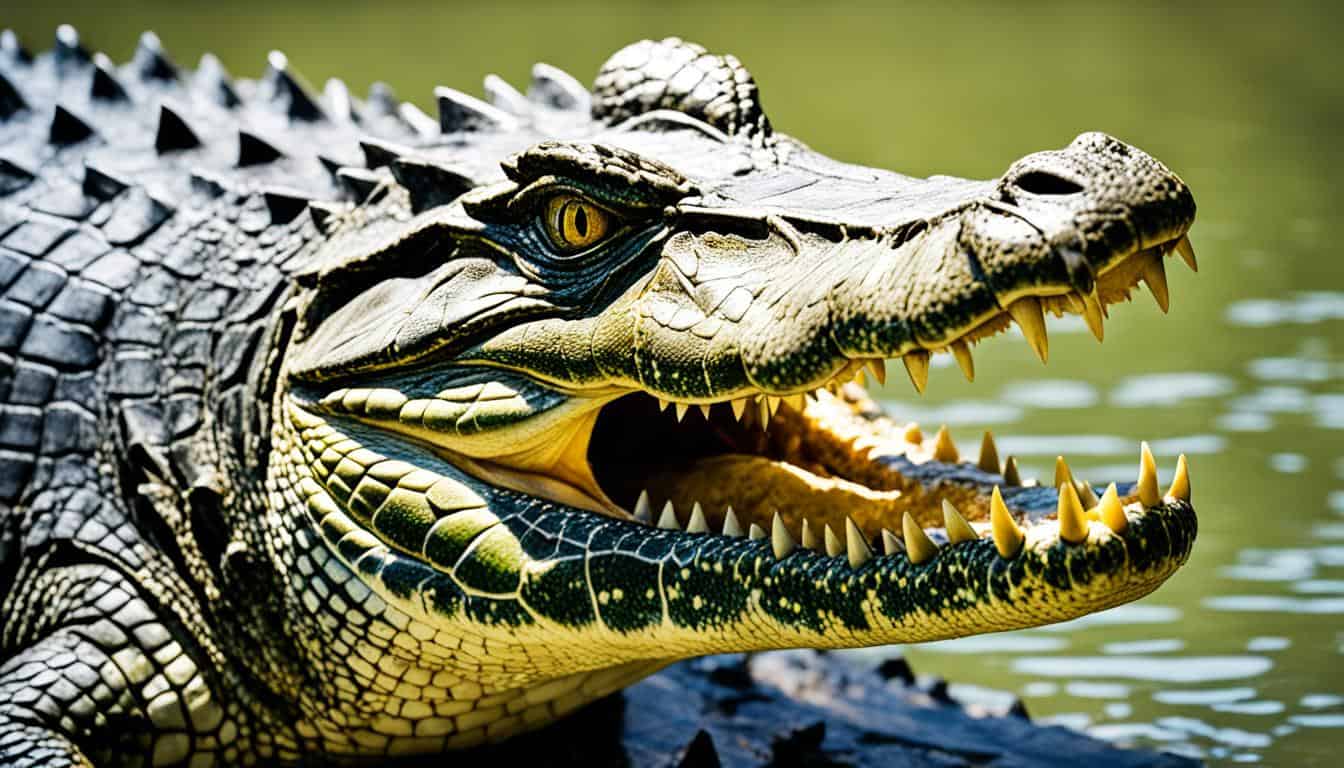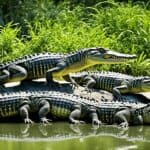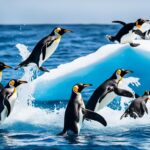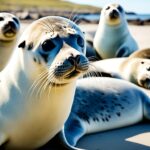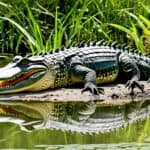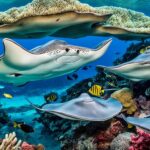Crocodiles are among the oldest reptiles on Earth, evolving over millions of years. They are top predators, crucial for their ecosystems. They keep the balance and help their habitats stay healthy.
Learning about crocodiles shows their amazing biology and why we need to protect them. They face threats like losing their homes and being hunted illegally. We must spread the word and teach others about their importance.
Join us as we explore the world of crocodiles. Discover fascinating facts that show how vital they are to nature.
What are crocodiles?
Crocodiles are fascinating creatures that belong to the family Crocodylidae. They are ancient predators with a deep history. These animals live in many parts of the world and have unique physical traits. Understanding their classification and biology helps us appreciate their evolution and role in nature.
Understanding their classification and biology
To understand crocodiles, we must look at their classification. They fall under the order Crocodylia, which also includes alligators and caimans. The family Crocodylidae has many species, each suited to its environment. Crocodiles are top predators, known for their strong bodies and powerful jaws.
Physical characteristics that define crocodiles
Crocodiles have physical traits that help them thrive. Their tough skin protects them and helps them blend in with their surroundings. Their V-shaped snouts are crucial for hunting. The size of crocodiles varies, with some, like the saltwater crocodile, reaching over 20 feet long.
| Characteristic | Description |
|---|---|
| Family | Crocodylidae |
| Skin Type | Scaly |
| Snout Shape | V-shaped |
| Size Range | Up to 20+ feet depending on species |
| Distribution | Worldwide in tropical and subtropical regions |
Crocodile facts that will amaze you
Crocodiles are fascinating creatures that capture our attention. They are apex predators with unique traits. This section shares some amazing facts about them, showing their status as living fossils and their incredible abilities.
Crocodiles as living fossils
Crocodiles are often seen as living fossils. They have stayed mostly the same for about 200 million years. Their long history, dating back to the Late Triassic period, shows their ability to adapt and survive through tough times.
These adaptations help us understand how crocodiles evolved. They give us a peek into the past while showing how resilient these reptiles are.
Insights into their extraordinary bite force
The crocodile’s bite is famous for being one of the strongest in the animal world. They have huge jaw strength, letting them break bones and catch big prey easily. This strength is key for their hunting, helping them catch fish, birds, and mammals.
Their power to take down prey makes them top predators in their world.
| Crocodile Species | Bite Force (psi) | Feeding Habits |
|---|---|---|
| Saltwater Crocodile | 3,700 | Fish, birds, mammals |
| Nile Crocodile | 2,500 | Fish, large mammals, carrion |
| American Crocodile | 1,500 | Fish, crustaceans, small mammals |
Types of crocodiles: A closer look at species
Exploring the world of crocodiles reveals many species, each with unique traits and behaviors. The saltwater, Nile, and American crocodiles stand out. They live in different places and show distinct characteristics.
Saltwater crocodile: The largest reptile
The saltwater crocodile is the biggest reptile on Earth. It lives in various places, from estuaries to coastal areas. This lets them survive in both fresh and saltwater.
They are known for their aggressive nature. This makes them top predators, hunting fish, birds, and even big mammals. They rule their habitats with strength.
Nile crocodile: Africa’s formidable predator
The Nile crocodile is a top predator in Africa. It calls freshwater places like rivers, lakes, and swamps home. It’s known for its aggressive nature.
This has made it a legendary creature in history and stories. It ambushes its prey, showing its power in its ecosystem.
American crocodile: Shy yet powerful
The American crocodile is different from its aggressive cousins. It lives in coastal areas of Central and South America, in both fresh and saltwater. They prefer places like mangroves and estuaries.
Even though they’re less aggressive, they’re still strong predators. They avoid humans, so they’re not often seen by people.
| Species | Size | Habitat | Behavior |
|---|---|---|---|
| Saltwater Crocodile | Up to 23 feet | Brackish and saltwater environments | Aggressive and territorial |
| Nile Crocodile | Up to 16.5 feet | Freshwater rivers and swamps in Africa | Aggressive ambush predator |
| American Crocodile | Up to 20 feet | Coastal and brackish waters | Reclusive, avoids humans |
Crocodile characteristics: What makes them unique?
Crocodiles have many traits that help them live in different places. They are top predators because of their survival skills. These traits show how complex their lives are.
Adaptations for survival in various habitats
Crocodiles live in both water and on land. Their strong limbs make swimming and moving on land easy. They also have great senses that help them hunt and find their way around.
| Adaptation | Description |
|---|---|
| Body Temperature Regulation | Crocodiles adjust their body temperature through sun basking and seeking shade, allowing them to cope with various climates. |
| Camouflage | Their skin pattern blends seamlessly with aquatic environments, aiding in stealth while hunting. |
| Aquatic Breathing | They can hold their breath for extended periods, making them effective ambush predators underwater. |
Social behaviors among crocodiles
Crocodiles are not just solitary animals. They have complex social behaviors. Many species form groups, especially during dry seasons. These groups help with staying warm and finding mates, showing how they adapt socially to survive.
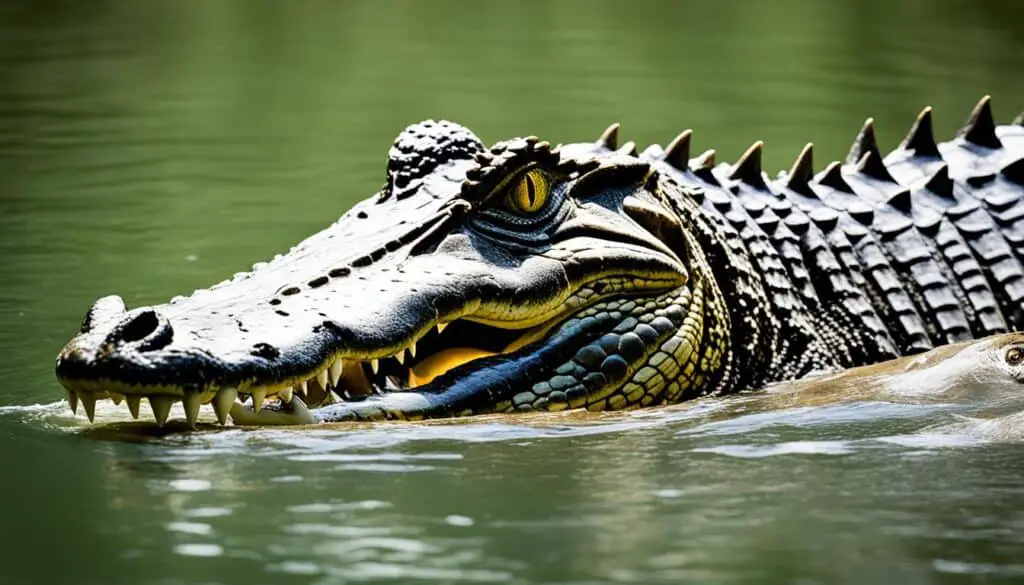
Crocodile habitat: Where do they thrive?
Crocodiles are very adaptable and live in many aquatic places. They love rivers and swamps because they need these for food and to make babies. These places are key for their survival.
Diverse aquatic environments they inhabit
You can find crocodiles in many places, such as:
- Rivers and swamps
- Lakes
- Marshes
- Coastal regions
These places meet their needs, making them essential for crocodiles. They can live in both fresh and salty water, showing how adaptable they are.
Importance of wetlands and estuaries
Wetlands and estuaries are very important. They are where crocodiles breed and find food. Knowing how they help the ecosystem shows why their habitat is so important:
| Aspect | Wetlands | Estuaries |
|---|---|---|
| Habitat Diversity | Supports various flora and fauna | Mix of fresh and saltwater species |
| Nutrient Availability | High nutrient levels for prey | Rich nutrient-rich waters |
| Crocodile Function | Breeding and basking sites | Feeding grounds during migrations |
Healthy wetlands and estuaries are key for the ecosystem. Keeping them safe is crucial for crocodiles and other animals that live there.
Crocodile conservation: Protecting these ancient predators
Your support for crocodile conservation can make a big difference. Many crocodile species are endangered due to habitat loss, hunting, and human-wildlife conflicts. These threats push them closer to extinction, highlighting the need for action.
Efforts to save crocodiles are underway. Protecting their habitats is key, allowing them to live in their natural settings. Educational programs also help local communities understand the value of crocodiles and how we can live with them.
Helping with conservation efforts helps protect endangered species and their ecosystems. You can help by volunteering, spreading the word, or supporting local projects. Every bit counts in the fight to save these incredible animals for the future.
FAQ
What are crocodiles?
Crocodiles are big, semi-aquatic reptiles in the family Crocodylidae. They’ve been around for millions of years. They are key predators, playing a big role in keeping ecosystems balanced.
How big can crocodiles grow?
Crocodiles can get really big, depending on the type. The saltwater crocodile can be over 20 feet long, making it the biggest living reptile.
What do crocodiles eat?
Crocodiles eat a wide variety of food, like fish, birds, and mammals. Their strong jaws and bite force let them ambush and catch different prey.
Are crocodiles solitary or social creatures?
Some think crocodiles live alone, but certain types, like the Nile crocodile, live in groups. These groups are called “basks,” especially in dry seasons.
Where do crocodiles live?
Crocodiles live in various water habitats, such as rivers, lakes, marshes, and coastlines. They can adapt to many environments, which helps them survive.
How do crocodiles contribute to their ecosystems?
As top predators, crocodiles control prey numbers and keep their water ecosystems healthy. This helps with biodiversity and keeps the ecosystem balanced.
What efforts are being made for crocodile conservation?
Conservation efforts include protecting their homes, reducing conflicts with humans, and stopping illegal hunting. Teaching people about the need to save crocodiles is also important.
How do crocodiles reproduce?
Crocodiles lay eggs, which are called oviparous. Female crocodiles build nests with plants or dirt near water. They take care of their baby crocodiles after they hatch.
What are some unique adaptations of crocodiles?
Crocodiles have tough skin for protection, a V-shaped snout for hunting, and can control their body temperature. These features help them survive.
What threats do crocodiles face today?
Many crocodile species are endangered because of lost habitats, illegal hunting, and conflicts with humans. Conservation efforts work to fight these threats and help crocodiles survive.
Source Links
- https://www.nhm.ac.uk/discover/news/2021/december/early-crocodile-ancestor-shows-how-reptiles-became-feared-aquatic-predators.html
- https://medium.com/@tysuess/crocodiles-ancient-predators-of-the-reptilian-world-b00347b4e013
- https://www.freetheocean.com/journal/exploring-the-fascinating-world-of-crocodiles/

